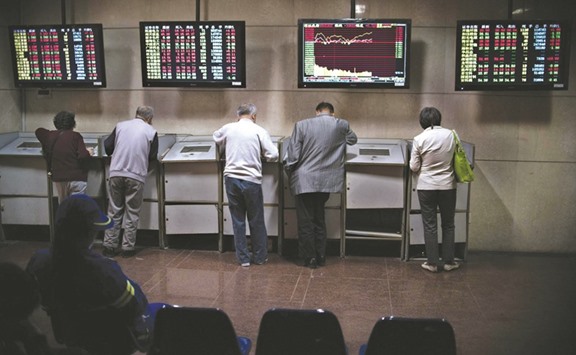China’s stock market was the world’s second-worst over the past year. Analysts covering it didn’t do much better.
The rout in the Shanghai Composite Index, which has lost more than a third of its value since the end of April 2015, followed one of the benchmark’s best rallies ever and shocked global markets as indicated by how badly the analysts covering Chinese equities performed. Their predictions were off by bigger margins than those of analysts researching stocks in the rest of the world’s 20 largest markets.
Had they been right, the gauge would be 43% higher than last week’s 2,938 close on the Shanghai Composite, according to data compiled by Bloomberg, which uses weighting metrics to convert consensus price targets for companies to index forecasts reflecting analysts’ collective wisdom. Predictions for the benchmark gauge are based on about 2,000 target prices for stocks constituting three-quarters of its weight.
The worst call among the index’s biggest 25 companies was Citic Securities Co, which is 54% below its consensus target price a year ago of about 36 yuan ($5.56) after losing half its value.
“The capital market is hardly predictable,” said Zheng Chunming, a Shanghai-based analyst at Capital Securities Corp, who had a buy rating on Citic last year with a target price well above where it is now. Making matters more difficult were two of the worst months in the Shanghai index’s history, one of them exacerbated by Chinese regulators imposing an emergency trading halt early this year and then quickly abandoning it.
“From the rout in July to the selloff triggered by the circuit-breaker in January, they were all hard to predict,” Zheng said.
It isn’t unusual for analysts to miss badly when equities get hit hard. Year-ahead price targets from analysts covering Greece’s stock market at the end of 2013, just before the country’s credit crisis began taking its toll, proved to be the developed world’s least accurate, overshooting by 50%. In the financial crisis year of 2008, analysts in the 25 biggest markets missed by more than 120% on average.
At least analysts covering the Shanghai benchmark’s members got the past year’s direction correct: They collectively foresaw a 5.3% loss. That’s more than can be said for the professional prognosticators advising clients on the mainland’s US-traded shares: A year ago, they predicted an 11% gain in the Bloomberg China-US Equity Index, which instead fell 9.7%.
The forecasts for the Shanghai index were being issued as mainland speculators and novice investors were piling into shares at an unprecedented pace amid a surge in initial public offerings, driving the gauge up more than 150% in the year before it peaked on June 12, 2015. In the same period, analysts covering the index’s soaring stocks doubled their target prices.
Driven by anticipation that the government would continue deploying stimulus measures, sentiment soured when the economy sputtered amid tumbling commodity prices and policy flip-flops, triggering a selloff that drained $5tn from Chinese equities.
“Stock analysts are historically very bad at catching inflection points in the macro environment and forecasting exchange-rate moves,” said Michael Wang, a strategist at hedge fund Amiya Capital in London, which invests in Chinese equities. “Investors at the moment don’t really believe the bottom-up earnings forecasts in China, which remain too high and will need to come down again as in previous years.”
In addition to the government’s missteps in managing the selloff, the types of companies on China indexes make forecasting prices harder than elsewhere in the world, said Paul Christopher, Wells Fargo Advisors’ chief international investment strategist.
“The largest companies on there are owned by the government essentially,” he said in an interview in New York. “The government can tell them what to do - for example, no insider selling at all. They did that for a while last year.”
Chinese officials have taken unprecedented steps to shore up markets, including six interest-rate cuts since late 2014, suspension of initial public offerings and a ban on selling by major investors.
While China’s economy is showing signs of stabilising, some of the improvements are being fueled by borrowing. New credit in this year’s first three months topped $1tn for a record first quarter, helping gross domestic product to expand 6.7% - still the slowest pace in seven years.
The analysts are optimistic. Current estimates see the Shanghai index gaining 13% over the next 12 months. For US-traded shares of Chinese companies, they’re forecasting a 21% increase.

Investors follow financial information at a securities brokerage in Shanghai. The rout in the Shanghai Composite Index, which has lost more than a third of its value since the end of April 2015, followed one of the benchmark’s best rallies ever and shocked global markets as indicated by how badly the analysts covering Chinese equities performed.
